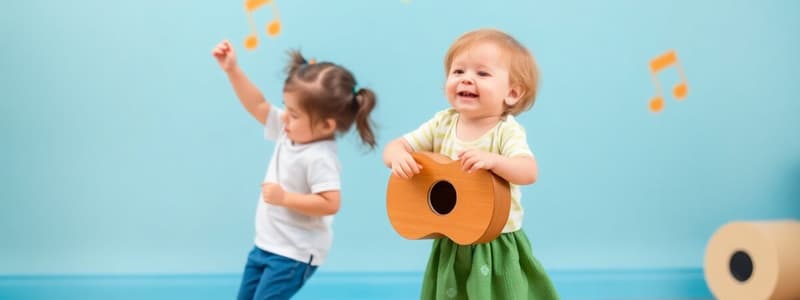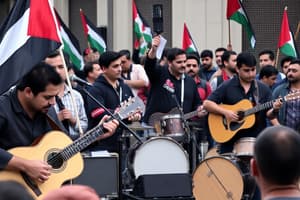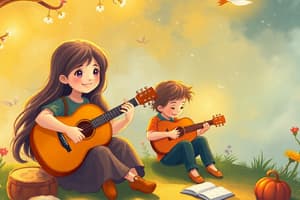Podcast
Questions and Answers
How do music and movement activities primarily contribute to children's social-emotional development?
How do music and movement activities primarily contribute to children's social-emotional development?
Which of the following musical provisions aligns with the environmental rating scale's recommendations for accessibility?
Which of the following musical provisions aligns with the environmental rating scale's recommendations for accessibility?
How does exploring sounds and rhythms of language primarily benefit children in the library area?
How does exploring sounds and rhythms of language primarily benefit children in the library area?
In what way do science and nature activities uniquely support social-emotional development in children?
In what way do science and nature activities uniquely support social-emotional development in children?
A child is using tweezers to pick up small objects during a science activity. Which type of development is this activity primarily supporting?
A child is using tweezers to pick up small objects during a science activity. Which type of development is this activity primarily supporting?
How do shared musical experiences contribute to a child's sense of cultural identity and self-esteem?
How do shared musical experiences contribute to a child's sense of cultural identity and self-esteem?
A teacher wants to integrate music and movement to support emotional regulation in the classroom. Which activity would be most effective?
A teacher wants to integrate music and movement to support emotional regulation in the classroom. Which activity would be most effective?
Which activity would best promote the development of both fine and gross motor skills simultaneously in a science and nature setting?
Which activity would best promote the development of both fine and gross motor skills simultaneously in a science and nature setting?
A teacher provides materials for children to measure ingredients and make silly putty. Besides fine motor skills, what other developmental area does this activity support?
A teacher provides materials for children to measure ingredients and make silly putty. Besides fine motor skills, what other developmental area does this activity support?
Which of the following strategies is least likely to foster literacy skills in a library area?
Which of the following strategies is least likely to foster literacy skills in a library area?
Flashcards
Music & Social-Emotional Connection
Music & Social-Emotional Connection
Shared songs and dances foster group belonging.
Music's Impact on Emotions
Music's Impact on Emotions
Lively music = energized movement; calm music = relaxation.
Movement as Emotional Expression
Movement as Emotional Expression
Expressing feelings through physical activity and dance.
Culture in Music
Culture in Music
Signup and view all the flashcards
Musical Games
Musical Games
Signup and view all the flashcards
Music accessibility
Music accessibility
Signup and view all the flashcards
Stories grow Language
Stories grow Language
Signup and view all the flashcards
Phonological Awareness
Phonological Awareness
Signup and view all the flashcards
Science & Social Skills
Science & Social Skills
Signup and view all the flashcards
Fine motor skills
Fine motor skills
Signup and view all the flashcards
Study Notes
- Music and movement activities foster social-emotional development by creating shared experiences and a sense of belonging.
- Music can influence emotions and actions, with lively music energizing children and soothing music calming them.
- Children express emotions through physical movement
- Sharing music and dance from home enhances self-esteem and cultural pride.
- Musical games promote social skills through cooperation.
- Environmental rating scales suggest daily access to music and movement activities for free choice.
- You should provide varied musical experiences like recorded music, dance props, and instruments daily.
- Weekly music or movement instruction is suggested.
- Special musical activities should be offered monthly.
- Literacy activities in the library area enhance reading, writing, listening, and speaking skills.
- Children expand vocabulary and comprehension through stories.
- Exposure to language sounds and rhythms in books develops phonological awareness.
- Children learn print directionality (left to right, top to bottom).
- Science and nature activities support social-emotional development by encouraging teamwork, exploration, and problem-solving.
- Caring for living things teaches responsibility and respect for rules.
- Science and nature activities support physical development through fine motor skill practice.
- Fine motor skills are developed by using tools like eyedroppers and tweezers.
- Dexterity and eye-hand coordination are improved through activities involving gears, disassembly, and magnets.
- Gross motor skills are strengthened by activities like using pulleys, creating shadows, and running.
Studying That Suits You
Use AI to generate personalized quizzes and flashcards to suit your learning preferences.
Description
Explore how music and movement nurture children's social-emotional growth. Sharing diverse musical experiences boosts self-esteem and cultural pride. Discover how music influences emotions, promotes cooperation, and enhances literacy skills.




